Infantry Equipment, Pattern 1914 - Ammunition Pouches
Pouches, ammunition, 60 rounds
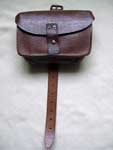
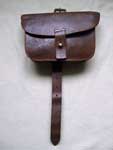
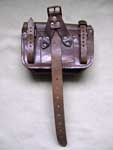
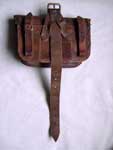 The Pattern 1914 Ammunition pouches were introduced with the Pattern 1914 Infantry Equipment in List of Changes entry L. of C. §16977, dated 30 August 1914. Each of the interchangeable Pouches is designed to hold 60-rounds of .303-inch ammunition, 50-rounds in a disposable cotton bandolier and another ten rounds in two 5-round chargers held in the inner pocket. Each Pouch has a single strap on the front to secure the cover, and two straps and buckles on the rear to secure it to the Waist belt. At the rear, the chape for the Brace buckle is a two-piece assembly consisting of a Vee and a turned over strap. This single buckle extends upward rear centre and is fastened to the front end of the Brace. Another 1-inch strap extends downward from the rear of the Pouch. The Pouch lid is hooded by darting (butt-stitched) and roll-overs stitched at the edge sections. As with all leather parts of the W.E. Patt. '14 , the colour was changed from "Service Dress" to "London Brown" by L. of C. §17219, with approval dates of 31 December 1914 and 30 March 1915. The same L. of C. also modified the "turn down" of the two rear straps, and strengthened the straps by sewing as well as riveting them in place. This British made pair are in London Brown. It is interesting to note the detail differences - the Pouch far left, for example, has a rivetted strap on the front flap, whilst the strap on the second Pouch is sewn - we believe that this feature is probably indicative of a 1st issue Pouch. The rivets are British hose rivets on both, but they also differ in detail. No doubt the two Pouches were from different manufacturers. They are not maker marked or dated, but are marked to an individual soldier. This pair are owned a British collector who wishes to remain anonymous.
The Pattern 1914 Ammunition pouches were introduced with the Pattern 1914 Infantry Equipment in List of Changes entry L. of C. §16977, dated 30 August 1914. Each of the interchangeable Pouches is designed to hold 60-rounds of .303-inch ammunition, 50-rounds in a disposable cotton bandolier and another ten rounds in two 5-round chargers held in the inner pocket. Each Pouch has a single strap on the front to secure the cover, and two straps and buckles on the rear to secure it to the Waist belt. At the rear, the chape for the Brace buckle is a two-piece assembly consisting of a Vee and a turned over strap. This single buckle extends upward rear centre and is fastened to the front end of the Brace. Another 1-inch strap extends downward from the rear of the Pouch. The Pouch lid is hooded by darting (butt-stitched) and roll-overs stitched at the edge sections. As with all leather parts of the W.E. Patt. '14 , the colour was changed from "Service Dress" to "London Brown" by L. of C. §17219, with approval dates of 31 December 1914 and 30 March 1915. The same L. of C. also modified the "turn down" of the two rear straps, and strengthened the straps by sewing as well as riveting them in place. This British made pair are in London Brown. It is interesting to note the detail differences - the Pouch far left, for example, has a rivetted strap on the front flap, whilst the strap on the second Pouch is sewn - we believe that this feature is probably indicative of a 1st issue Pouch. The rivets are British hose rivets on both, but they also differ in detail. No doubt the two Pouches were from different manufacturers. They are not maker marked or dated, but are marked to an individual soldier. This pair are owned a British collector who wishes to remain anonymous.
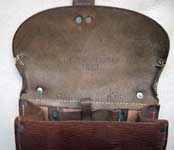
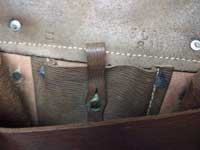 These detail pictures show closeups of the markings and interior of one of the Pouches above. Note the charger pocket.
These detail pictures show closeups of the markings and interior of one of the Pouches above. Note the charger pocket.
KW reader Simon Jervis has just sent in some new information bourt this particular Pouch, ammunition:
The number 1213 and the name refer to Pte Ernest Charles William Massey, 1213-240057 of the 1/5th battalion Leicestershire Regiment. The second marking is likely to refer to the 3rd (reserve) battalion Leicestershire regiment. I have attached a copy of Ernest Massey's medal index card. If he wore the 1914 pattern leather equipment during his time in France it is very likely that he wore it during the battle of Loos in 1915 and particularly during the attack on the Hohenzollern Redoubt on the 13th October.
Thank you, Simon, for this interesting bit of historical detail.
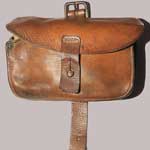
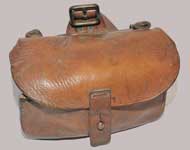 An example of a 1st issue Pouch, ammunition, 60 rounds. The front strap is sewn, not rivetted, and it has the short, rivetted turndown on the rear straps. The maker's mark is illegible, but it is dated 1914. This very early date, together with its being London Brown, once again suggest that there was very little Patt. '14 actually produced in the Service Dress colour. This Pouch is part of a set in which all of the components are marked "7 RH 054", i.e. 1/7th (Fife) Battalion Black Watch TF. The numerals 054 are the service number of the original owner. From the Paul Hannon Collection, photo © Paul Hannon 2011.
An example of a 1st issue Pouch, ammunition, 60 rounds. The front strap is sewn, not rivetted, and it has the short, rivetted turndown on the rear straps. The maker's mark is illegible, but it is dated 1914. This very early date, together with its being London Brown, once again suggest that there was very little Patt. '14 actually produced in the Service Dress colour. This Pouch is part of a set in which all of the components are marked "7 RH 054", i.e. 1/7th (Fife) Battalion Black Watch TF. The numerals 054 are the service number of the original owner. From the Paul Hannon Collection, photo © Paul Hannon 2011.
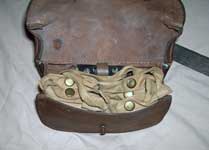
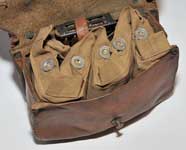 Two examples of Pouches, ammunition with contents. Each contains a Bandolier, cotton, 50 rounds (Mark II.), complete with .303-inch ammunition in chargers, and two additional 5-round chargers (one with bullets up, one down) in the rear pocket. The example far left is from the Chris Pollendine Collection, photo © Chris Pollendine 2010. This Pouch is one of the American made pair shown directly below, whilst the Bandolier is maker marked "T.B. (L) Ltd." and dated 1913. The British made example near left is from the Paul Hannon Collection, photo © Paul Hannon 2011. It is interesting to note the differences between the two Bandoliers. Both are Mk. II's, but the pre-war example has the push spring buttons called for by L. of C. §15627, whilst Paul's WWI example (maker marked "Hamptons Ltd." and dated 4/15) used the zinc uniform buttons commonly encountered on Bandoliers of this vintage.
Two examples of Pouches, ammunition with contents. Each contains a Bandolier, cotton, 50 rounds (Mark II.), complete with .303-inch ammunition in chargers, and two additional 5-round chargers (one with bullets up, one down) in the rear pocket. The example far left is from the Chris Pollendine Collection, photo © Chris Pollendine 2010. This Pouch is one of the American made pair shown directly below, whilst the Bandolier is maker marked "T.B. (L) Ltd." and dated 1913. The British made example near left is from the Paul Hannon Collection, photo © Paul Hannon 2011. It is interesting to note the differences between the two Bandoliers. Both are Mk. II's, but the pre-war example has the push spring buttons called for by L. of C. §15627, whilst Paul's WWI example (maker marked "Hamptons Ltd." and dated 4/15) used the zinc uniform buttons commonly encountered on Bandoliers of this vintage.
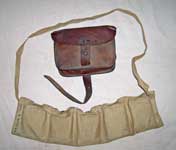
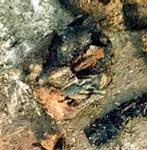 At far left, another picture of Chris P's Pouch and Bandolier shown left above. Near left, a unique photo from Paul Hannon, taken on the Somme in 2009. In the full size photo, note the Patt. '14 Ammunition pouch at lower left, still filled with cartridges. Also note that there is no sign of a Bandolier - the rounds were loose in the Pouch. Apparently, this was not uncommon. In the same photo, a Water bottle can be seen at lower right. Photo at far left, © Chris Pollendine 2010; near left, © Paul Hannon 2009.
At far left, another picture of Chris P's Pouch and Bandolier shown left above. Near left, a unique photo from Paul Hannon, taken on the Somme in 2009. In the full size photo, note the Patt. '14 Ammunition pouch at lower left, still filled with cartridges. Also note that there is no sign of a Bandolier - the rounds were loose in the Pouch. Apparently, this was not uncommon. In the same photo, a Water bottle can be seen at lower right. Photo at far left, © Chris Pollendine 2010; near left, © Paul Hannon 2009.



 The colour change from Service Dress to London Brown is discussed in detail in the page on Colour. In the case of Ammunition pouches, though, L. of C. §17219 also lengthened the "turn down" of the two rear straps, and strengthened the straps by sewing as well as riveting them in place. These detail pictures demonstrate precisely what that modification actually entailed. Far left, the rear strap of the 1st issue Pouch illustrated above, showing the original short, rivetted turndown. Second from left, an intermediate form - the turndown is still short, but it is now sewn as well. Third from left, another intermediate variation. On this Pouch, the turndown has been lengthened and double rivetted, but it is not sewn. Although this example is British made, it's worth noting that American Pouches all seem to be made in this way. It appears, though, that the double rivets were not carried over into the final variation. The example near left illustrates the modification as it was defined in L. of C. §17219. This seems to have been the final version - as late as WWII, Line-man Pouches (see below) were still being made in this way. The three leftmost examples are from the Paul Hannon Collection, photos © Paul Hannon 2011. The example near left is from the Chris Pollendine Collection, this photo © Chris Pollendine 2011.
The colour change from Service Dress to London Brown is discussed in detail in the page on Colour. In the case of Ammunition pouches, though, L. of C. §17219 also lengthened the "turn down" of the two rear straps, and strengthened the straps by sewing as well as riveting them in place. These detail pictures demonstrate precisely what that modification actually entailed. Far left, the rear strap of the 1st issue Pouch illustrated above, showing the original short, rivetted turndown. Second from left, an intermediate form - the turndown is still short, but it is now sewn as well. Third from left, another intermediate variation. On this Pouch, the turndown has been lengthened and double rivetted, but it is not sewn. Although this example is British made, it's worth noting that American Pouches all seem to be made in this way. It appears, though, that the double rivets were not carried over into the final variation. The example near left illustrates the modification as it was defined in L. of C. §17219. This seems to have been the final version - as late as WWII, Line-man Pouches (see below) were still being made in this way. The three leftmost examples are from the Paul Hannon Collection, photos © Paul Hannon 2011. The example near left is from the Chris Pollendine Collection, this photo © Chris Pollendine 2011.
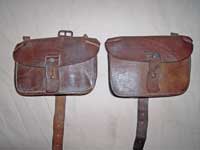
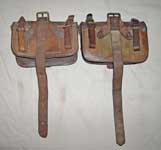 Front and rear views of a pair of American made Pouches, Ammunition, 60 rounds. As with the British pair above, the clear detail differences between these two Pouches indicate that, whilst both American made, they are from different manufacturers. In fact, the left-most Pouch is maker marked "Cook", whilst the other is marked "Simmons/Keen Cutter". Both are dated 1915. From the Chris Pollendine Collection.
Front and rear views of a pair of American made Pouches, Ammunition, 60 rounds. As with the British pair above, the clear detail differences between these two Pouches indicate that, whilst both American made, they are from different manufacturers. In fact, the left-most Pouch is maker marked "Cook", whilst the other is marked "Simmons/Keen Cutter". Both are dated 1915. From the Chris Pollendine Collection.
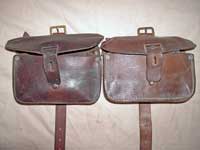 A British made Pouch on the left, with an American made one on the right. From the Chris Pollendine Collection, all photos © Chris Pollendine 2011.
A British made Pouch on the left, with an American made one on the right. From the Chris Pollendine Collection, all photos © Chris Pollendine 2011.
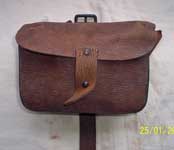
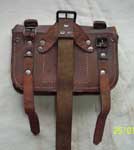
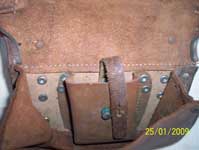 Another example of American Patt. '14 production. Note the steel rivets, particularly well illustrated in the interior shot. Also note that the rear straps are rivetted only, whilst the front strap is both sewn and rivetted (but with a single rivet, not two like the rivetted-only British ones above and below). From the Steve Hewitt Collection, photographs © Steve Hewitt 2009.
Another example of American Patt. '14 production. Note the steel rivets, particularly well illustrated in the interior shot. Also note that the rear straps are rivetted only, whilst the front strap is both sewn and rivetted (but with a single rivet, not two like the rivetted-only British ones above and below). From the Steve Hewitt Collection, photographs © Steve Hewitt 2009.
Pouches, ammunition, 60 rounds, leather. Pattern modified.
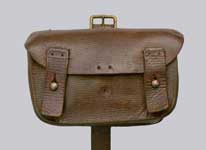


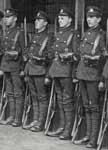 There is another version of the Ammunition pouch which has two front straps to secure the cover. This change was introduced by List of Changes entry L. of C. §20642, dated 5 February 1918. The L. of C. entry addresses both specifications for new manufacture and alterations to existing Pouches, but all of the examples KW have seen have been conversions of single strap ones. At left, a conversion from a Pouch with a single rivetted front strap. From the John Bodsworth Collection, photo © John Bodsworth 2011. At right, an interesting picture provided by Paul Hannon. It shows men of the 2nd Bedfordshires, 34th Division, in March, 1919. Note the mix of single and double strap Patt. '14 Pouches.
There is another version of the Ammunition pouch which has two front straps to secure the cover. This change was introduced by List of Changes entry L. of C. §20642, dated 5 February 1918. The L. of C. entry addresses both specifications for new manufacture and alterations to existing Pouches, but all of the examples KW have seen have been conversions of single strap ones. At left, a conversion from a Pouch with a single rivetted front strap. From the John Bodsworth Collection, photo © John Bodsworth 2011. At right, an interesting picture provided by Paul Hannon. It shows men of the 2nd Bedfordshires, 34th Division, in March, 1919. Note the mix of single and double strap Patt. '14 Pouches.
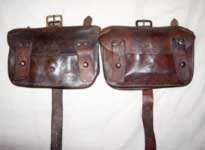
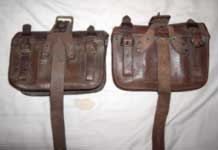 An interesting mis-matched pair of modified Pouches, which appear to have been issued and used together. The Pouch at left in each photo is British made, undated but maker marked "T.Douthwaite Ltd Newcastle O/T" (on Tyne that is). It is a first issue, with single short riveted down turn to rear strap. There is greenish tinge where the leather is unexposed, and it may have originally been coloured Service dress. The Pouch at right in each photo is U.S. made. It is unmarked and undated, but likely 'Cook' made, as it is identical to others from that American maker. From the Chris Pollendine Collection, photographs © Chris Pollendine 2012.
An interesting mis-matched pair of modified Pouches, which appear to have been issued and used together. The Pouch at left in each photo is British made, undated but maker marked "T.Douthwaite Ltd Newcastle O/T" (on Tyne that is). It is a first issue, with single short riveted down turn to rear strap. There is greenish tinge where the leather is unexposed, and it may have originally been coloured Service dress. The Pouch at right in each photo is U.S. made. It is unmarked and undated, but likely 'Cook' made, as it is identical to others from that American maker. From the Chris Pollendine Collection, photographs © Chris Pollendine 2012.
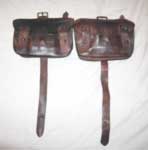
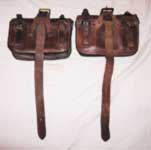 Full view, including strap, of the two Pouches shown above.
Full view, including strap, of the two Pouches shown above.
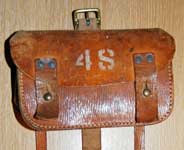
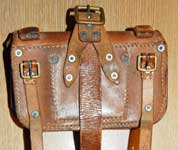 Although almost identical to Patt. '14 Ammunition pouches, Pouches, tool, line-man are not part of I.E., Patt. '14, and can be distinguished from Patt. '14 Pouches by one obvious difference. On Patt. '14 Pouches, the chrome side of the central rear strap is to the front. On the Line-man pouch, this is reversed, with the flesh side to the front. These Pouches are properly discussed in their own section of Non-Patterned Equipment, but are briefly mentioned here because they are clearly derived from Pattern 1914 Ammunition pouches, and are often confused with them (in one instance, in a reference book by a well-known author). This example is maker marked "B.H.G." (Barrow, Hepburn, and Gale), and dated 1944. From the Rog Dennis Collection, photos © Rog Dennis 2011.
Although almost identical to Patt. '14 Ammunition pouches, Pouches, tool, line-man are not part of I.E., Patt. '14, and can be distinguished from Patt. '14 Pouches by one obvious difference. On Patt. '14 Pouches, the chrome side of the central rear strap is to the front. On the Line-man pouch, this is reversed, with the flesh side to the front. These Pouches are properly discussed in their own section of Non-Patterned Equipment, but are briefly mentioned here because they are clearly derived from Pattern 1914 Ammunition pouches, and are often confused with them (in one instance, in a reference book by a well-known author). This example is maker marked "B.H.G." (Barrow, Hepburn, and Gale), and dated 1944. From the Rog Dennis Collection, photos © Rog Dennis 2011.